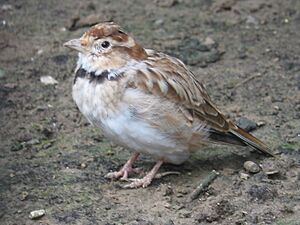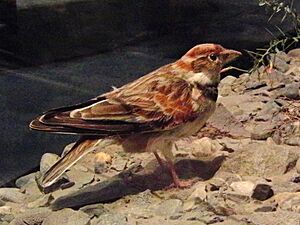Mongolian lark facts for kids
Quick facts for kids Mongolian lark |
|
|---|---|
 |
|
| Conservation status | |
| Scientific classification | |
| Genus: |
Melanocorypha
|
| Species: |
mongolica
|
 |
|
| Mongolian lark range, green - resident, yellow - breeding, blue - non-breeding | |
| Synonyms | |
|
|
The Mongolian lark (Melanocorypha mongolica) is a type of lark bird. It belongs to the Alaudidae family. You can find these birds in places like southern Russia, Mongolia, and central China.
Mongolian larks are famous for their amazing singing. Even when they are grown up, they can still learn new songs! Male Mongolian larks sing a lot. They have special parts in their brains that help them learn and remember many different songs. Female Mongolian larks do not sing, but their brains are also built to understand these songs.
This bird is an indicator species. This means it helps scientists understand the health of bird biodiversity. It is especially important in the Mongolian steppes. If the Mongolian lark population is doing well, it often means other birds in the area are also healthy.
You will most often see a Mongolian lark by itself. One of its main predators is the Saker Falcon.
About the Mongolian Lark
The Mongolian lark was first named by a scientist in 1776. It was originally placed in a different group of birds called Alauda. Sometimes, people also call this bird the Mongolian sand-lark or the Mongolian skylark.
What Does It Look Like?
The Mongolian lark has a pale brown head. It has a reddish crown, which is the top part of its head. Its upper body is reddish-brown. The lower part of its body is yellowish-white.
Life Cycle and Nesting
Mongolian larks lay about three eggs at a time. The parents sit on the eggs to keep them warm for about 13 days. This is called incubation. After the eggs hatch, the baby birds stay in the nest for about 10 days. Sadly, only about half of the eggs usually survive to hatch and grow.



